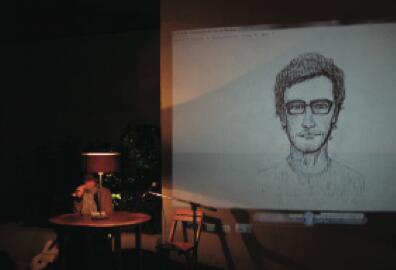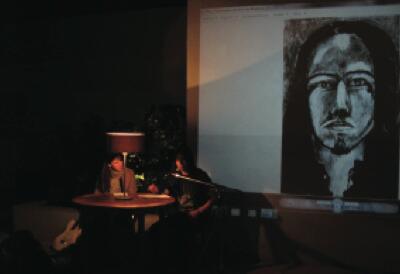SOMA
News of a Parallel, Interacting Art World
SOMA made its appearance as “ a school of experimental art” during that last January of the 2000s decade, when Mexican art became international. It was an invention that combined the yearning for something lost in the past the period of the 90s, when artists had no galleries or museums, but shared collective atmospheres of effervescent creativity and thinking and the decision to recover and expand a certain way of generating visions in an artists’ place for artists, in which not even the idea of “exhibiting” let alone that of selling − might eclipse the possibility of art as a shared universe in constant development.

When those alternative spaces of the 1990s like La Quiñonera, the Ex Teresa, Temístocles 44, or la Panadería − which opened the way for Postmodernism in Mexico City closed, and their members, as Olivier Debroise pointed out, “began the search for new paths”, “and started to walk individually,” galleries that projected artists beyond their country’s boundaries emerged or became more firmly established, but at the same time, cultural communities weakened. The feeling that artists had placed their bet on the market and had finally realized that an element was missing, that people were isolated, or devoted solely to self- promotion, gradually opened the way for the need to recover an atmosphere of collective training and creation, and of exchange among local generations and with actors forming part of the international art scene, outside of the established circuits.
Yoshua Okon the soul of La Panadería and Eduardo Abaroa one of the initiators of T44 founded SOMA featuring an artist residency program, an educational project which has something in common with the Peripatetic School (dialogues, wanderings as routes of discoveries forged by multiple voices), and which includes a summer course delivered in English − SOMA Summer − and the idea of Wednesday Night Activities with an echo reminiscent of Roberto Bolaño’s The Savage Detectives, while simultaneously exploring those overlappings of the boundaries between visual arts, music, philosophy and literature, dance and “reventón” (party) that increasingly dissolves them.
Thus, SOMA emerged bearing the name of the substance supplied to the inhabitants of Huxley’s Brave New World, but also that of a group therapy based on the ideas of Wilhem Reich the creator of the orgone accumulator, connected to vital energy and designed by Roberto Freire in Brazil, and that of the sensible acronym Secretariat for the Organization of Media and Art, all of which concentrates ambiguous readings and open possibilities under the direction of Bárbara Hernández. From the very outset this project manager has provided a structure to SOMA’s bet, in a process of adjustments aimed, above all, at conjugating a verb in the art world: “to interact”. A practice supported by a strong council composed of artists including Carlos Amorales, Teresa Margolles, Silvia Grunner, Jorge Méndez Blake and many others who, as Abaroa remarks, make their contribution towards “rendering art not only plural but also more relevant.”
“There is no doubt about it, we shall soon meet again”: An implicit slogan. There is no doubt about it, we shall soon meet again. Such the title of the exhibition presented at the Casa del Lago Juan José Arreola, which had its origin in the Projects Class that Mario García Torres proposed to the artists participating in SOMA’s training program, and who enrolled in it seeking to recreate the experience of the legendary teaching method conceived by David Askevold in Halifax: to produce works based on the instructions delivered by different artists during the workshop. But the title of that show, which was somehow an exception, since it was scheduled to take place not at the SOMA headquarters but elsewhere since the institution is not interested in incorporating another exhibition space in the art scene epitomizes the spirit of interchange that drives the institution, as well as the determination to activate other forms of mobility between education and interaction in contemporary art, which has rallied together both artists from different parts of Mexico and from the whole of Latin America.
Artists in their formative stage, such as those who participated in the Projects Class − Ricardo Alzati, Dulce Chacón, Gabriel Escalante, David Alejandro Hernández, Rolando López, Noé Martínez, Antonio Monroy and Verónica Rojas − have the chance to interact with prominent curators who do not only deliver lectures but who also take the time to examine potfolios following an agenda based solely on the chronological order in which applications were received. Such the case of Julieta González, Associate Curator of Latin American Art at Tate Modern and of other prominent guests. Taiyana Pimentel shared the experience of curating Sensitive Negotations at the Mexican Cultural Institute in Miami; Gonzalo Soltero offered an “Apocalyptic Narratives” Clinic, and Manuel Rocha shared his vision on Sound Art. Artists such as Jorge Méndez-Blake or Sofía Taboas will deliver courses, and Okon himself will teach courses that propose in-depth interaction experiences with curators or artists, including those invited to participate in the SOMA residency program. In February the guest artist will be Angie Waller, who has developed an oeuvre inspired by the materials found in the “esoteric landscape” of those who carry out this type of activity, and which includes not only a series of prints that revolve around the place of white magic in the social networks, but also a performance based on free consultations. In 2010, Hannah Rickards was among the residents, thanks to the support of the Gasworks International Fellowships Programme.
SOMA Summer, on the other hand, is a six-week program conducted in English in Mexico City, and it offers a series of short seminars and workshops delivered by renowned local and international artists, as well as the possibility of meeting with curators to obtain an individual critical analysis of their work. This summer, the thematic emphasis will be focused on the methods of appropriation and re-use, including discussions on the ready-made, the copy, and the “remix” culture. The program includes visits to museums and studios, and an event based on the open-studio model. Among the Mexican artists who will conduct seminars and workshops in 2011, mention may be made of Carla Herrera-Prats, who lives in New York and is in charge of the project, Eduardo Abaroa, Gonzalo Lebrija and Mariana Botey. The program will also include the participation of US artists Anthony Graves, Larissa Harris, and Nate Harrison, British artist Nils Norman, and the Chilean curator Anthony Huberman. The individual reviews will be conducted by the curators Ruth Estévez, Cuauhtémoc Medina, Gonzalo Ortega, Víctor Palacios, Bárbara Perea and Jorge Reynoso.
Since February, the interaction in the blog has increased and the talks are being recorded as part of an archive that will somehow be a testimony of how to create a platform to activate cultural communities not interested solely in the production of objects that respond to the market, but also in generating discourses. SOMA’s essence ultimately produces an empowerment of artists which goes beyond the market behavior and elicits that which the market does not: a community dimension.








